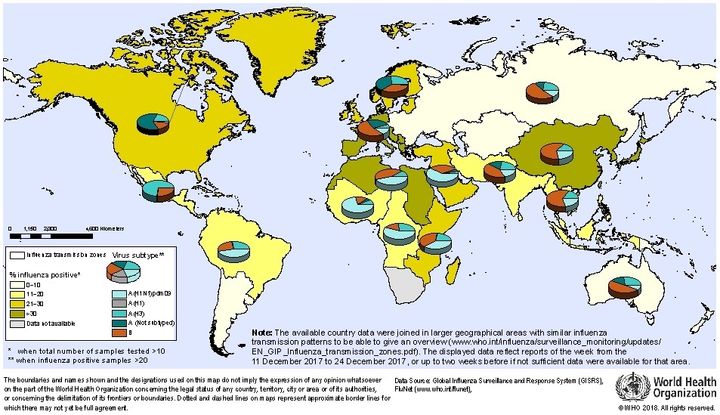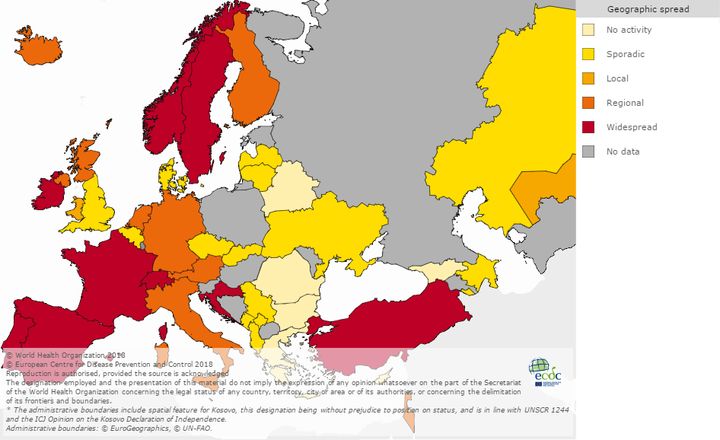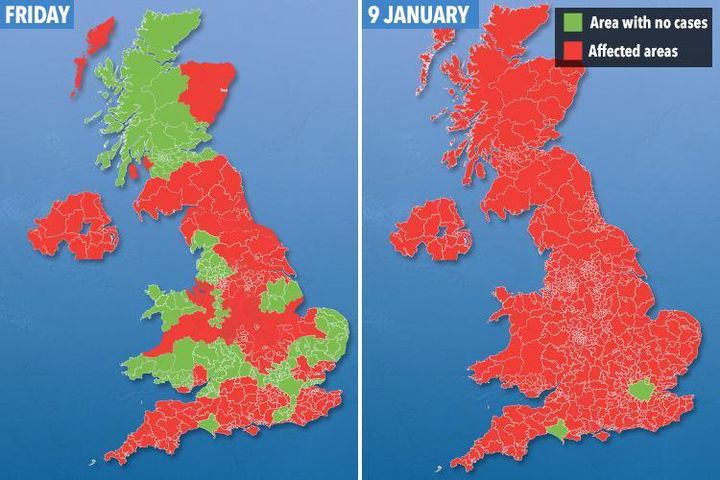
Flu activity is still on the rise in the Northern Hemisphere.
Flu activity is still on the rise in the Northern Hemisphere, with influenza A (H3N2) and influenza B making up most of the cases, while some countries are reporting influenza A (H1N1) pdm09 activity.

Worldwide, influenza A (H3N2) and B viruses accounted for the majority of influenza detections although influenza A(H1N1)pdm09 viruses were predominant in some countries.
In the US, emergency rooms all across the country are filling up with flu patients, some pharmacies have run out of medicine, and the death toll is higher compared to previous years. Now, 46 states and the District of Columbia are experiencing widespread flu activity. Only Hawaii, Maine, New Hampshire, and New Jersey are reporting regional levels of influenza. Before the end of December, at least 106 deaths have been reported to the CDC. One pediatric death was reported last week, bringing the total number of pediatric deaths for the 2017-18 season to 13. The flu season in the US usually starts in October and ends in May, peaking from December to February, so more cases and deaths can be expected. Influenza A (H3N2) – the problem child of seasonal flu - is predominant. Doctors became even more worried after an editorial published in the New England Journal of Medicine said that this year’s vaccine was only 10 percent effective against A (H3N2) in Australia.

Flu activity in the US reported by state and territorial epidemiologists indicating geographic spread of influenza viruses.
In northern, southern, and western Europe, the flu increase has been sharp in many countries, with influenza B being predominant, while the main influenza A subtype varies by country. Of the type A detections, A (H1N1) pdm09 viruses have outnumbered A (H3N2) viruses. In the past, the commonly held view was that influenza B infections are milder than influenza A, but studies have shown that flu B virus can be as severe as flu A and that clinicians should remember this when considering treatment options.

Geographic spread of flu in Europe
In the UK, flu A (H3N2) has spread to almost all parts of the UK. London and Dorchester were the only places with no reports of “influenza-like illness”. Churches have reportedly banned handshakes in an attempt to curb the spread of the virus. What is more worrying is that only 44% of kids aged eight to nine years old have been vaccinated and kids are "super-spreaders" because they pick up the virus and pass it on their classmates in school and their family back home. The flu causes an average of 8,000 deaths every year in England and Wales.

The flu virus has continued to spread across the UK.
West, East, and South Asian countries also reported increased flu levels. In the Middle East, flu in Jordan was mainly the A (H1N1) pdm09 strain, while influenza B was predominant in Israel. In East Asia, disease activity increased in China and South Korea, led by the influenza B Yamagata lineage, followed by A (H3N2). South Korea also reported the same pattern. In Southern Asia, influenza activity was reported in Iran, with increased activity from all three seasonal flu strains.
In northern Africa, flu activity increased in Tunisia, Egypt, and Morocco, mainly due to influenza A (H1N1) pdm09. In western Africa, the flu showed signs of decline, although influenza A (H1N1) pdm09 was the predominant strain in some locations such as Burkina Faso, Côte d’Ivoire, Ghana, and Togo.
Globally, influenza A made up 65.2% of detections. Of the sub-typed influenza A viruses, 69.3% were H3N2 and 30.7% were H1N1 pdm09. Of the characterized B viruses, 86.3% belonged to the B-Yamagata lineage while 13.7% belonged to the B-Victoria lineage.
Health officials recommend a yearly flu vaccine for everyone aged 6 months and older, as it is still the most effective way to prevent flu. Studies show that even if a vaccinated person catches the flu, their illness is much milder. Healthy adults can be infected (without symptoms) and can pass the virus on to someone else. The flu could end up being deadly for that person, especially if they’re elderly or very young. The TED-Ed video below explains why it is important to have an annual flu shot.
Young kids are among the most vulnerable to flu complications, and the flu vaccine has been shown to significantly reduce the risk of death from flu. The high-dose flu vaccine is recommended for elderly people who are vulnerable to flu infection, hospitalization, and death. This occurs because the immune system becomes weaker with age, and aging decreases the body’s ability to have a good immune response after getting the flu vaccine.
People are advised to avoid those who are sick, and this has been shown to prevent sick people from spreading the virus. Antiviral treatment is most effective when initiated after the onset of illness, but treatment initiated later than 48 hours after onset can still be beneficial for some patients.
